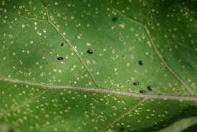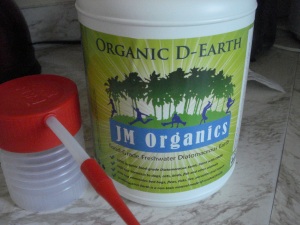I had an outbreak of flea beetles.
I didn’t know what they were at first. I wasn’t too concerned because they didn’t devastate anything earlier in the season. The primary damage was lots of tiny holes in leaves of mostly cabbage family stuff (kale, pac choi , etc) and radishes. But then, some plants wilted and died (indicating root damage), and I got tired of eating holey greens.
I decided to track down the problem. The clues I gathered before doing my research: drought year, cabbage family, small, round holes in the leaves, and total wilt and death of some plants. Could it be one pest??????? Indeed.
I was able to identify the critter by looking at photos of leaf damage in my books. Flea beetles! They are very small so not usually seen in the garden unless you tote around a magnifier. The adults create the holes in the leaves when they feed. THEN, they go into the soil and lay eggs. The hatched larvae feed on plant roots, causing the wilt. AND, flea beetles do this four times in the season. That is just too much flea beetle hanky panky on church property.
Flea Beetle Damage
Flea Beetles and Damaged Leaf
And why this year? They thrive in drought years : (
Keeping the leaves misted with an overhead water supply is one of the organic control methods. Lovely mists are not an option at the moment, so I continued my research. Most sources recommend the organic standby–diatomaceous earth.
By the way, I also have more than my fair share of cutworms and diatomaceous earth helps there too.
Wikipedia describes diatomaceous earth this way:
Diatomaceous earth consists of fossilized remains of diatoms, a type of hard-shelled algae.” Diatomite is used as an insecticide, due to its physico-sorptive properties. The fine powder absorbs lipids from the waxy outer layer of insects’exoskeletons, causing them to dehydrate.
This also works against gastropods and is commonly employed in gardening to defeat slugs. However, since slugs inhabit humid environments, efficacy is very low. It is sometimes mixed with an attractant or other additives to increase its effectiveness. This material has wide application for insect control in grain storage. It has also been used to control bedbug infestations, but this method may take weeks to work.
I was not able to obtain any locally, so I ordered from Amazon. I also got a nifty, low-tech little applicator. Both arrived today, so at dusk I went out and spread some around. The applicator worked best without the red tip on the end. Even though this is a safe product, I don’t want it in my lungs, so I tied a bandanna around around my face, like a bandit.
I will keep you posted on how this works. I have high expectations as this product has been documented many times as very effective.




